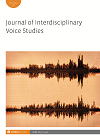-
oa Ballad of the dork-o-phone: Towards a crip vocal technoscience
- Source: Journal of Interdisciplinary Voice Studies, Volume 4, Issue 2, Oct 2019, p. 179 - 189
-
- 01 Oct 2019
Abstract
Abstract
This piece elucidates the related politics of vocal impairment and vocal prosthesis through a close analysis of the Spokeman Personal Voice Amplifier, a.k.a., the dork-o-phone. Drawing from voice theory, disability studies and phenomenology, I present an analysis of the dork-o-phone in use and challenge the boundaries between disability and impairment. In the process, I also show how vocal impairments and protheses ultimately give the lie to the idea that voices are self-sufficient and can exist without supplementation.
Copyright: © 2019 Intellect Ltd
This work is licensed under a Creative Commons Attribution Unported License. To view a copy of this license, visit Creative Commons Attribution Non-Commercial License (CC BY-NC), which allows users to copy, distribute and transmit an article, adapt the article as long as the author is attributed and the article is not used for commercial purposes



